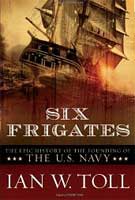 Two hundred and seventeen years ago today, March 27, 1794, the United States Congress authorized the construction of six frigates, the first ships of the United States Navy, the USS Constitution, the USS Chesapeake , the USS Constellation , the USS President, the USS United States, and the USS Congress. The ships were designed to be heavy frigates – longer and faster than the conventional frigates of their day, able to stand and fight against any ships their size and fast enough to evade larger ships of the line. Innovative structural design involving diagonal bracing allowed US shipbuilders to build longer and faster frigates than was previously thought practical. The ships more than held their own against the Royall Navy. The six frigates were also significantly over budget and delivered later than anticipated, a tradition proudly upheld in military contracting to this day.
Two hundred and seventeen years ago today, March 27, 1794, the United States Congress authorized the construction of six frigates, the first ships of the United States Navy, the USS Constitution, the USS Chesapeake , the USS Constellation , the USS President, the USS United States, and the USS Congress. The ships were designed to be heavy frigates – longer and faster than the conventional frigates of their day, able to stand and fight against any ships their size and fast enough to evade larger ships of the line. Innovative structural design involving diagonal bracing allowed US shipbuilders to build longer and faster frigates than was previously thought practical. The ships more than held their own against the Royall Navy. The six frigates were also significantly over budget and delivered later than anticipated, a tradition proudly upheld in military contracting to this day.
Continue reading
 Every US naval ship and most American merchant ships carry aboard a copy of the American Practical Navigator, which most refer to simply as Bowditch, after Nathaniel Bowditch, the author of the first edition in 1802. On March 26, 1773, Nathaniel Bowditch, the fifth of seven children, was born in Salem, Massachusetts, to a seafaring family of limited means. Apprenticed as a bookkeeper, he was a self taught mathematician with a particular interest in navigation.
Every US naval ship and most American merchant ships carry aboard a copy of the American Practical Navigator, which most refer to simply as Bowditch, after Nathaniel Bowditch, the author of the first edition in 1802. On March 26, 1773, Nathaniel Bowditch, the fifth of seven children, was born in Salem, Massachusetts, to a seafaring family of limited means. Apprenticed as a bookkeeper, he was a self taught mathematician with a particular interest in navigation.
Bowditch had the radical notion that navigation could be made simple enough so that everyone aboard the ship, including the cook, could be taught to navigate.
Continue reading
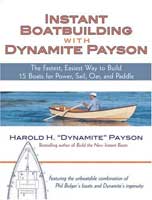 Harold ‘Dynamite’ Payson died suddenly of an an aneurysm at his home in Maine on March 23rd. He was 82.
Harold ‘Dynamite’ Payson died suddenly of an an aneurysm at his home in Maine on March 23rd. He was 82.
His message was simple. As expressed in his books and on his webpage,” Harold H. Payson … known to associates, friends, and his wife as Dynamite… thinks you can build a boat. In fact, if you can saw a penciled line, apply glue, drive nails, and bring a modest measure of patience to the task, you can build and launch a smart and able craft in as few as 40 work hours. You need not be driven by lack of tools, materials, skills, or time to abandon in frustration a project you conceived in a spirit of pleasurable anticipation.”
Continue reading
This is an amazing presentation from a website called “everybody loves cephalopods.” (I know that I do, usually lightly fried.) I have to admit that after watching this excerpt from a 30 minute presentation by Maggie Koerth-Baker that I am indeed fascinated by octopus brains. Definitely worth a look.
[iframe: title=”YouTube video player” class=”youtube-player” type=”text/html” width=”480″ height=”295″ src=”http://www.youtube.com/embed/KyGazPZmmM0″ frameborder=”0″ allowFullScreen]
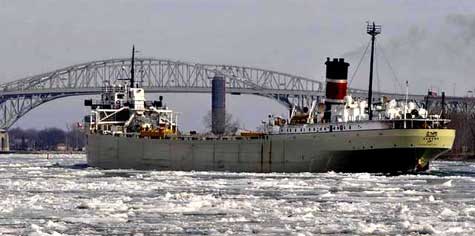
The wonderful thing about the US Great Lakes is that being fresh water, the ships on the lakes don’t rust like they do in the saltier oceans. Of course being fresh water, the lakes do freeze close enough to solid in the wintertime, so shipping comes to a halt. In recent weeks the ships have started moving on the St. Clair River . Earlier this week the St. Lawrence Seaway and the Welland Canal opened for business and today the Soo Locks between Lake Superior and the lower lakes are scheduled to ocean. The Great Lakes are a wonderful if sometimes confusing place. The water is fresh and there are no tides. The ships, even the 1,000′ bulk carrier,s too large to fit out of the locks, are referred to as “boats” and every travels in miles per hour.
Seaway Opens 53rd Season, 7% Increase Projected
Thanks to Phil Leon for passing the article along.
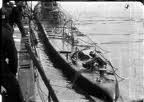 On March 24th, 1945 the USS Lancetfish was decommissioned after less than thousand hours in service. She never put to sea under her own power and never had a crew. Delivered from the Cramp Shipbuilding Company of Philadelphia, she was towed to the Boston Navy Yard for additional work. A shipyard worker opened a torpedo tube door and the sub sank in seven fathoms of water. She was judged too damaged to be worth repairing and was laid up until 1959 when she was finally sold for scrap.
On March 24th, 1945 the USS Lancetfish was decommissioned after less than thousand hours in service. She never put to sea under her own power and never had a crew. Delivered from the Cramp Shipbuilding Company of Philadelphia, she was towed to the Boston Navy Yard for additional work. A shipyard worker opened a torpedo tube door and the sub sank in seven fathoms of water. She was judged too damaged to be worth repairing and was laid up until 1959 when she was finally sold for scrap.
Thanks to Dave Shirlaw on the Marine History List for passing the story along.
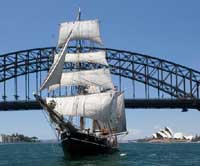 Earth Hour is “a global event organized by WWF (World Wide Fund for Nature, also known as World Wildlife Fund) and is held on the last Saturday of March annually, asking households and businesses to turn off their non-essential lights and other electrical appliances for one hour to raise awareness towards the need to take action on climate change.” The observation of Earth Hour began in Sydney, Australia in 2007. This year, in Sydney harbor, the Tall Ship Southern Swan is offering an Earth Hour Twilight Cruise, which sure sounds better than sitting at home in the dark.
Earth Hour is “a global event organized by WWF (World Wide Fund for Nature, also known as World Wildlife Fund) and is held on the last Saturday of March annually, asking households and businesses to turn off their non-essential lights and other electrical appliances for one hour to raise awareness towards the need to take action on climate change.” The observation of Earth Hour began in Sydney, Australia in 2007. This year, in Sydney harbor, the Tall Ship Southern Swan is offering an Earth Hour Twilight Cruise, which sure sounds better than sitting at home in the dark.
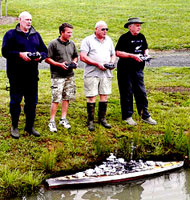 This Sunday a grand of fleet of miniature ships will sail the lake at East Tamaki, a suburb of Auckland, New Zealand. The event is being hosted by Task Force 48, a group of radio-controlled model ship enthusiasts.
This Sunday a grand of fleet of miniature ships will sail the lake at East Tamaki, a suburb of Auckland, New Zealand. The event is being hosted by Task Force 48, a group of radio-controlled model ship enthusiasts.
The 1:48 scale replicas of the full-size Royal New Zealand Navy ships will carry out fleet manoeuvres on a lake in Highbrook.
Continue reading
 For those in New York there is a special program, Women At Sea: Screening, Conversation, Reception, next Wednesday, March 30th, at the Community Church of New York, 40 East 35th Street, New York, NY at 6:00 PM. The program features a screening of the PBS documentary “Shipping Out—The Story of America’s Seafaring Women” followed by a conversation with seven women mariners who work as captains, mates, engineers and pilots.
For those in New York there is a special program, Women At Sea: Screening, Conversation, Reception, next Wednesday, March 30th, at the Community Church of New York, 40 East 35th Street, New York, NY at 6:00 PM. The program features a screening of the PBS documentary “Shipping Out—The Story of America’s Seafaring Women” followed by a conversation with seven women mariners who work as captains, mates, engineers and pilots.
Tickets are $20 and can be purchased at through the Working Harbor Committee.
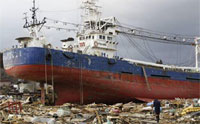 “The newest landmark in the tsunami-stricken city of Kesennuma.”
“The newest landmark in the tsunami-stricken city of Kesennuma.”
Ghost ship haunts tsunami-hit Japanese city
The newest landmark in the tsunami-stricken city of Kesennuma is a massive fishing trawler that was swept up at sea and came to rest on one of the main roads to City Hall. The No. 18 Kyotoku-maru ship, with a red and blue hull and a “safety first” slogan painted just above its bridge, looms over a landscape of homes and business splintered by the March 11 tsunami and then set ablaze in an ensuing fire.
Continue reading
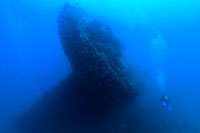 Today is the 100th anniversary of the tragic sinking of the passenger ship SS Yongala in a cyclone off Australia with the loss of 122 lives.
Today is the 100th anniversary of the tragic sinking of the passenger ship SS Yongala in a cyclone off Australia with the loss of 122 lives.
CAIRNS tourism pioneer Charles Woodward is today heading for the shipwreck that claimed the life of his great grandmother Mary – and all her fellow passengers – exactly a century ago.
Continue reading
The calendar says that Spring is here on the banks of the Hudson River, but it is nevertheless snowing outside. On mornings like this it is good to be reminded of warm seas and white sails. The good folks on the Soren Larsen recently posted a video that does just that.
[iframe: title=”YouTube video player” width=”480″ height=”300″ src=”http://www.youtube.com/embed/6_S-pSErCX8″ frameborder=”0″ allowfullscreen]

The Super Moon over Glastonbury Tor, Somerset
We posted a few days ago about Saturday’s “Super Full Moon” the first time in almost twenty years that full moon coincided with perigee, the passing of the moon’s orbit closest to the earth. Now the “Super Moon” is being blamed for causing five ships to run aground. We are a bit skeptical of the claims.
‘Blame it on the super moon!’ Five ships run aground off British coast as lunar phenomenon lowers tide
Continue reading
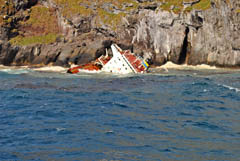
Photo: Sean Burns
Last Wednesday the bulk carrier MV Olivia ran aground on Nightingale Island in the Tristan da Cuhna archipelago in the South Atlantic. See our previous post. By Friday, she had broken up in heavy seas with 1,500 tonnes of heavy fuel oil in her bunker tanks. The spilled oil is threatening wildlife, including nearly half of the world population of endangered Northern Rockhopper penguins. There is also serious concern that if the vessel was harboring rats that they could be an even greater threat to land birds on previously rodent-free island. Poison and bait stations are being sent to the island.
Oil still leaking from the Oliva at Tristan’s Nightingale Island

Photo: Janet Jordon
When I first came to New York thirty five years ago, the closest thing to wildlife in the waters of the harbor were what we referred to as “Hudson River trout” – condoms that had been flushed through the New York sewer system into the river, that seemed to swim in and out with the tides. Fortunately things have changed considerably since then. Last April we posted about a harbor seal which chose to sunbathe in the Hudson River on the remains of an old Jersey City dock, directly across from Manhattan. For over a hundred years there had been no seals in New York harbor until in 2006 when they began to return. This year there is a colony of seals on Swinburne Island, just outside the mouth of the inner harbor. Seal watching boats have been running every weekend. Seal watching season ends in New York by about the end of April when most seals migrate north.
Continue reading
 A very interesting presentation at the New Bedford Whaling Museum on Tuesday evening for those in the area.
A very interesting presentation at the New Bedford Whaling Museum on Tuesday evening for those in the area.
Commander Andrew J. Norris, USCG, will examine modern piracy in the next Sailors’ Series lecture on Tuesday, March 22 at 7:30 p.m. in the Cook Memorial Theater, New Bedford Whaling Museum.
Continue reading
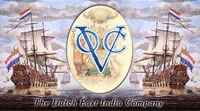 On March 20th, 1602 the Vereenigde Oost-Indische Compagnie, the VOC, or in English, the United Dutch East India Company was established as a chartered company. It would dominate European trade with Asia for almost 200 years.
On March 20th, 1602 the Vereenigde Oost-Indische Compagnie, the VOC, or in English, the United Dutch East India Company was established as a chartered company. It would dominate European trade with Asia for almost 200 years.
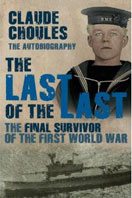 Claude Choules, the last surviving combat veteran of World War I celebrated his 110th birthday with family and friends in Perth earlier this month. Though he served in two World Wars, the first in the Royal Navy and the second in the Australian Navy, he hated war according to his son, who said that he only marched in Anzac Day parades when he was ordered to.
Claude Choules, the last surviving combat veteran of World War I celebrated his 110th birthday with family and friends in Perth earlier this month. Though he served in two World Wars, the first in the Royal Navy and the second in the Australian Navy, he hated war according to his son, who said that he only marched in Anzac Day parades when he was ordered to.
Claude Choules, last World War I veteran ‘hated war,’ says son
He’s the last known male survivor of more than 70 million military personnel during WWI, after American veteran Frank Buckles passed away on Sunday also aged 110.
Continue reading
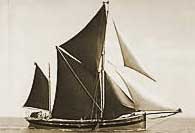 Last November, we posted about the rebuilding of the last commercial Thames sailing barge, Cambria. The reconstruction is nearing its completion. Tomorrow, Monday 21st March, 2011, the Cambria will be relaunched into Faversham Creek, and move downstream to Iron Wharf to complete fitting-out.
Last November, we posted about the rebuilding of the last commercial Thames sailing barge, Cambria. The reconstruction is nearing its completion. Tomorrow, Monday 21st March, 2011, the Cambria will be relaunched into Faversham Creek, and move downstream to Iron Wharf to complete fitting-out.
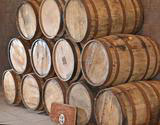
Photo: Mark Teiwes
We can only wish them the best of luck and look forward to trying their rum.
Rum’s in the family – Ipswich distillery inspired by privateer ancestor
It seems Andrew Cabot has inherited not only his name, but some business sense and a taste for rum from his ancestor.
Continue reading
